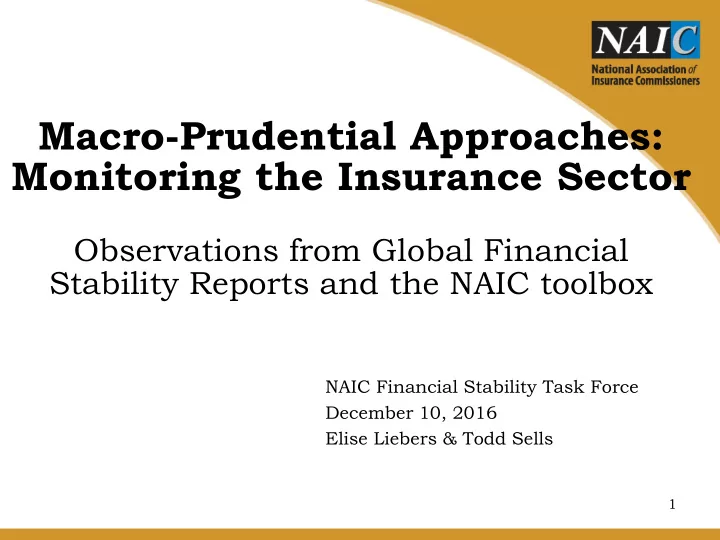

Macro-Prudential Approaches: Monitoring the Insurance Sector Observations from Global Financial Stability Reports and the NAIC toolbox NAIC Financial Stability Task Force December 10, 2016 Elise Liebers & Todd Sells 1
Context • Review of reports of global supervisors that provide insights on macro- prudential surveillance efforts – Identify risks / themes and how they are being addressed • While micro-prudential approach focuses on strength of individual firms; a macro-prudential approach focuses on stability of the financial system 2
Report Focus • Integrated regulators, Central Banks, Financial Stability Regulators : Topics range from monetary policy to state of markets, to financial stability, to micro/macro prudential supervision. – How financial institutions impact leverage, liquidity transformation and other systemic risk • Reference insurance sector potential impact on systemic risks, but focus on the banking sector 3
Broad Themes “Low For Long” Liquidity Interconnectivity Insurance Sector Reports Uncertainty: Cybersecurity New Players, Technology Procyclicality 4
Tools: Good Data • Consistently reported, timely, automated – Insurance Data • YoY trends in investment and underwriting profitability, capital adequacy, leverage, concentrations • Investment allocation, business lines, guarantees, liability liquidity features, financial counterparties, NTNI activities – Economic and financial market data 5
Stress Testing • Assess impact on the insurance industry of common exposures to financial market risks • Assess impact on financial system of extreme events impacting a subset of the insurance sector • Stresses – Regulator prescribed, others allow more firm specific flexibility. – Single, double and multiple hit scenarios being tested – Consider both direct and knock on impacts 6
Micro Tools, Macro Purposes • Regulatory Capt’l • ORSA – pro-cyclicality, market – horizontal view risks • Information sharing • Reporting requirements • Recovery, resolution • Expanded Authorities and protection schemes – Limit or separate NTNI – Pro-cyclical Buffers – Limit dividends, intra group cash flows 7
IAIS Role • Annual Reports – Global Insurance Market Report (GIMAR) which discusses the global insurance sector from a supervisory perspective – Key Insurance Risks and Trends (KIRT) Survey • ICS, G SII Exercise & Policy Measures • Insurance Core Principle (ICP) #24: Macro prudential Surveillance and Insurance Supervision 8
US Approaches : Financial Stability and Macro Prudential Surveillance 9
Financial Stability • Primary Goals of NAIC Solvency Framework – Reduce the Likelihood of Insurer Failure – Maximize Amount of Assets Available to Pay Policyholders in the Event of a Failure • Refining/Improving Group Oversight – ORSA Filings, Form F, Group Capital Calculation • Micro-prudential Regulation Greatly Contributes to Financial Stability (Helps Prevent Distress and Contagion, Both Within and Outside the Group) 10
Macroprudential Regulation • Financial Crisis Prompted a Macroprudential Focus – Basel III Counter Cyclical Buffers and Tighter Capital Requirements and Leverage Caps – SIFI Designation for Nonbank Financial Entities – Monitoring of Areas of Risk (e.g., Securities Lending Data Calls) 11
US Financial Stability Reports • FSOC Annual Report, OFR Fin. Stability Report – Low U.S. and Global Interest Rates • Reaching for Yield and Increased Leverage • Challenges to Life Insurers (Guaranteed products) – Cybersecurity – Asset Management Products/Activities – Central Counterparties – Data Gaps (including Captives issues) 12
NAIC Macroprudential Monitoring • Still Focus on Primary Goals of Solvency – Peer Review Process of Financial Analysis WG – Industry Snapshots, Tool Results and Risk Alerts – Capital Markets Reports, Hot Spots, Newsletters – Chief Financial Regulator Forum – Ad Hoc Queries Responding to Events (e.g., Brexit) – Net Spread Over Guaranteed Interest Rate Study • Results Used by Regulators for Individual Insurers/Groups, to Modify NAIC Guidance 13
Should NAIC Be Doing More? • Traditional Argument Is No, Since State Insurance Regulators Have Historically Prioritized Policyholder Protection Over Broader Market Regulation • Is There A Middle Ground Where NAIC Can Maintain That Priority But Add Tools To Address Macroprudential Regulatory Concerns, e.g. Through Enhanced Monitoring and Reporting? • Should This Task Force Review and Provide Summary Reports On The Various NAIC Macroprudential Monitoring Activities, And Consider Potential Enhancements? 14
Recommend
More recommend